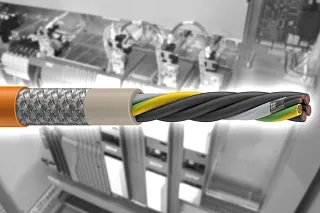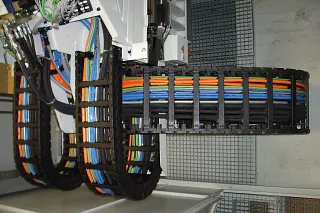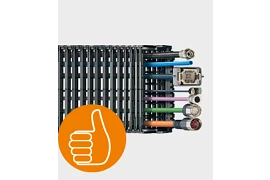Ubah Bahasa :

Kabel servo untuk energy chain
Dalam teknik kelistrikan, kita berbicara tentang kabel servo ketika kita mengacu pada kabel koneksi untuk drive servo. Kabel ini menghubungkan inverter frekuensi (FI) dan motor satu sama lain. Fakta bahwa FI adalah catu daya untuk motor memungkinkan kecepatan diubah dengan menyesuaikan bentuk gelombang tegangan. Hal ini biasanya dilakukan dengan modulasi lebar pulsa, yang menghasilkan puncak energi tinggi pada kurva tegangan. Oleh karena itu, kabel servo juga harus dilengkapi dengan kelas tegangan yang lebih tinggi, yaitu 600V/1000V, dan memiliki pelindung secara keseluruhan. Karena servomotors memiliki sensor suhu dan/atau rem, kabel untuk fungsi-fungsi ini berisi dua pasangan berpelindung tambahan.
Konstruksi kabel servo
Ada dua pelindung yang berbeda dalam kabel servo. Di satu sisi, ada pelindung keseluruhan, yang memastikan bahwa perilaku kompatibilitas elektromagnetik ke luar baik-baik saja. Ini berarti bahwa komponen lain dari mesin tidak terganggu. Kedua, pasangan untuk rem dan sensor suhu dilindungi, yang memastikan bahwa gangguan dari saluran listrik tidak memasuki sirkuit kontrol inverter frekuensi. Pelindung ini dirancang secara berbeda, tergantung pada tekanan mekanis. Semakin tinggi tingkat tekanan mekanis kabel, semakin tinggi kualitas pelindungnya. Dalam praktiknya, ini berarti bahwa pelindung kabel kelas atas kami memiliki cakupan mekanis yang jauh lebih tinggi hingga 90%. Selain itu, kami menggunakan belitan khusus untuk pasangan kontrol pada kabel yang tidak hanya memiliki spesifikasi kompatibilitas elektromagnetik yang baik, tetapi juga dapat diproses dengan sangat cepat berkat desain khususnya.

Mengapa tidak selalu harus PUR
PUR = kabel rantai dan PVC = instalasi tetap. Ini adalah kebijaksanaan konvensional di pasar kabel. Tetapi itu tidak sepenuhnya benar. Kami di igus® telah menguji berbagai bahan selubung luar secara ekstensif dan untuk waktu yang lama di laboratorium kabel kami dan sampai pada kesimpulan bahwa PUR adalah bahan yang sangat bagus dan fleksibel, tetapi tidak harus selalu digunakan dalam rantai.
Ini karena PVC memiliki sifat abrasi yang jauh lebih baik dan juga merupakan bahan yang lebih murah. Namun, PUR sangat diperlukan jika kabel bersentuhan dengan minyak.

kabel servo dalam berbagai aplikasi di alat mesin
Salah satu area aplikasi yang menggambarkan berbagai macam opsi berbeda untuk kabel servo dari program chainflex® adalah pada alat mesin yang saling terkait. Di sini, mesin sangat ketat pada berbagai sumbu, sehingga seri kabel CF270.UL.D kami umumnya digunakan. Jari-jari yang digunakan pada sumbu utama sering kali lebih besar, sehingga menghemat biaya jika menggunakan seri CF897. Seri ini memiliki panjang langkah yang lebih panjang pada stranding dan oleh karena itu dioptimalkan untuk radius tikungan yang lebih besar. Pada gantry di atas mesin yang saling terkait, e-chain® digunakan dalam perjalanan jauh dan jenis aplikasi ini membutuhkan jaket bagian dalam, yang dilengkapi dengan CF27.UL, untuk dinamika tinggi dan penggunaan rantai geser. Semua seri memiliki beberapa kesamaan yang sangat penting untuk peralatan mesin. Pertama, setiap kabel memiliki persetujuan UL, kedua jaket luar yang tahan minyak dan ketiga garansi tiga tahun dengan pernyataan masa pakai yang jelas hingga 10 juta pukulan ganda. Kita harus mengambil jalan bersama dan mengembangkan solusi hemat biaya dengan bantuan berbagai pilihan. Silakan hubungi spesialis kami segera.
Belum menemukan yang tepat?
Apakah Anda sudah mengetahui alat bantu online kami?
Mudah ditemukan, pilih jenis yang tepat, hitung masa pakai dan pesan secara online

Pencari produk
Temukan kabel yang tepat dengan cepat

kalkulator masa pakai
Hitung masa pakai kabel chainflex®

Kalkulator biaya tambahan tembaga
Menghitung biaya tambahan tembaga harian

Konfigurator untuk kabel khusus
Konfigurasikan kabel khusus Anda hanya dalam 3 menit

Apakah Anda masih mencari energy chain untuk kabel Anda?
Ke energy chains
... atau semuanya sudah jadi sebagai readychain®?
Ke readychainKonsultasi
Saya akan dengan senang hati menjawab pertanyaan Anda secara langsung

Pengiriman dan konsultasi
Secara pribadi:
Senin - Jumat dari jam 8.30 - 17.30 WIB
Online:
24 Jam
WhatsApp-Service:
Senin - Jumat dari jam 8.30 - 17.30 WIB